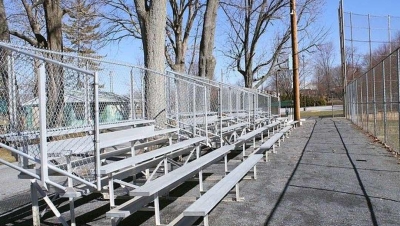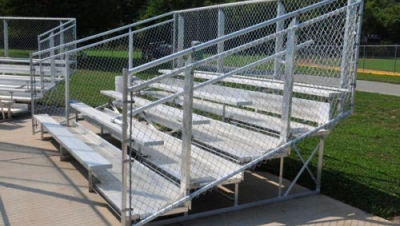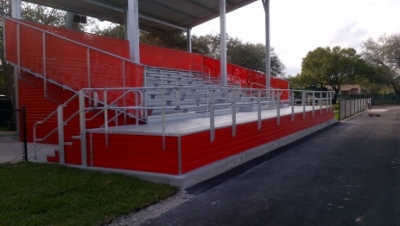The Hidden Hazards in Bleacher Safety
With Special Guest Andrew Sanchez
Every day of the year, American families visit parks, playgrounds, parades, concert halls, multiple purpose rooms, or sport facilities where they sit and enjoy watching games, concerts, or special events. The following are just a few examples of how many of us go out to catch a game or watch an event and enjoy ourselves.
The American Youth Soccer Organization (AYSO) has more than 50,000 teams and more than 600,000 players. (http://www.ayso.org/AboutAYSO/history.aspx)
ESPN lists the total number of people who attended a Major League Baseball game in 2012 as 74,859,268 (http://espn.go.com/mlb/attendance/_/year/2012)
2012 Concerts listed by revenue
- Madonna. No. of Shows: 72 - Attendance: 1,635,176
- Bruce Springsteen & ESB. No. of Shows: 72 - Attendance: 2,165,925
- Roger Waters. No. of Shows: 72 - Attendance: 1,680,042
- M Jackson TIWT by Cirque Du Soleil. No. of Shows: 183 - Attendance: 1,374,482
- Coldplay. No. of Shows: 67 - Attendance: 1,811,787
- Lady Gaga. No. of Shows: 65 - Attendance: 1,111,099
- Kenny Chesney & Tim McGraw. No. of Shows: 23 - Attendance: 1,085,382
- Van Halen. No. of Shows: 46 - Attendance: 522,296
- Jay-Z & Kanye West. No. of Shows: 31 - Attendance: 371,777
- Andre Rieu. No. of Shows: 99 - Attendance: 490,165
(Billboard.com)
But many times users do not notice the hazards in the bleachers on which they are sitting until it is too late and an incident has occurred! The U.S. Consumer Product Safety Commission (CPSC) Publication Number 330 “Guidelines for Retrofitting Bleachers” states: From 1991 through 1999, there was an annual average of 19,100 bleacher-associated injuries treated in emergency rooms (ER). Data from 1999 were examined in more detail. In 1999, there were an estimated 22,100 bleacher-associated injuries treated in ERs. Approximately 6,100 of these injuries were a result of the person falling from, or through, bleachers, onto the surface below. Approximately 4,910 of these falls involved children under the age of 15.
Bleacher safety is a mounting concern today and continues to grow. Proof of this is demonstrated in internet searches – type in bleacher safety into your search engine and many accident attorneys’ ads will appear. Today’s families are exposed to numerous hazards pertaining to unsafe bleachers every day. It all boils down to awareness and training of the staff that are responsible for inspecting and maintaining bleachers you and your family are using.
The International Code Council (Document ICC 300-2007) 501.2 Inspection states: “All existing tiered seating SHALL be inspected and evaluated at least once a year by a qualified person for compliance with the provisions of this chapter. All folding and telescopic seating SHALL be inspected to evaluate compliance with the manufacturer’s installation and operational instructions, including an inspection during the opening and closing of such seating.”
Frequencies of bleacher inspections should follow the guidelines of the ICC 300-2007, CPSC 330, manufacturer requirements, and be based on the amount of use. For instance, a football stadium that is operated by the local municipality that allows for the school district of 18 high schools to utilize the stadium should develop an aggressive, frequent, and proactive inspection and maintenance program to ensure the safety of their guests.
Hazards on bleachers may be caused by older designs, incorrect manufacturing, incorrect installation, or lack of routine maintenance. Bleachers should be thoroughly inspected to pinpoint any structural damage or hazards that may compromise the integrity of the bleacher and public safety. All hazards and deficiencies should be corrected immediately. In some cases repair times and deficiencies may result in rendering the bleachers inoperable and/or taken out of use.
Inspections and maintenance must be conducted in an efficient manner by certified and trained personnel.
Documentation of inspections and maintenance should be maintained for each location and include items such as date, inspector or maintenance staff’s name, and description of work that was performed. The documentation should be retained according to the appropriate jurisdiction’s recommendations and policy. Every bleacher should have a thorough inspection every year by a qualified inspector (ICC 200-2007 section 5.102) and a written inspection letter and certification explaining that the bleachers meet safety standards and are sound for public use should be supplied. All repairs should be consistent with the manufacturer’s recommendations.
Records of all incidents and injuries should be retained accordingly to the jurisdiction’s recommendations and policy. After an in-depth review of the incident and injuries, an agency should take corrective actions. The proactive approach of scheduled inspections and maintenance will help alleviate these types of incidents from occurring in the future.
For additional information you may wish to review:
Guidelines for Retrofitting Bleachers U.S. Consumer Product Publication No. 330 http://www.cpsc.gov/PageFiles/122347/330.pdf
International Code Council ICC 300-2007: Bleachers, Folding and Telescopic Seating, and Grandstands http://shop.iccsafe.org/icc-300-2007-bleachers-folding-and-telescopic-seating-and-grandstands.html




